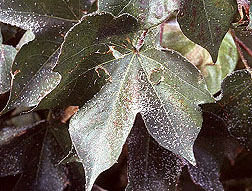This page has been archived and is being provided for reference purposes only. The page is no longer being updated, and therefore, links on the page may be invalid.
| Read the magazine story to find out more. |
|
|
|
|
Controlling Whiteflies the Natural Way
By Dennis O'BrienDecember 6, 2011
U.S. Department of Agriculture (USDA) scientists are showing Arizona cotton growers how to reduce their dependence on broad-spectrum insecticides by controlling sweetpotato whiteflies with greener alternatives.
Some Arizona growers continue to combat whiteflies with broad-spectrum insecticides that wipe out a number of insects, despite the availability of sprays that specifically target whiteflies. Steve Naranjo, a scientist with USDA's Agricultural Research Service (ARS), and Peter Ellsworth of the University of Arizona conducted a study where they treated some plots with insecticides specific to whiteflies and other plots with broad-spectrum insecticides. They left a third set of plots as untreated controls. Naranjo is a research leader and acting center director at the ARS U.S. Arid-Land Agricultural Research Center in Maricopa.
The results, published in Biological Control, showed that whiteflies initially died off at about the same rate in areas treated with both the whitefly-specific and the broad-spectrum insecticides. But as the growing season continued, the area where the researchers sprayed broad-spectrum insecticides had to be repeatedly sprayed to control whiteflies, while there was no need to spray the area treated once with the whitefly-specific insecticide. In those areas, the whitefly's natural enemies survived the initial spraying and continued to feed on whiteflies.
Naranjo and Ellsworth also found a way to reduce the impact of whitefly migration from cantaloupe to cotton, which is a persistent problem in Arizona. The researchers showed that when cantaloupe is grown near cotton, whiteflies will typically reach excessive levels on cotton in July, coinciding with the end of the cantaloupe harvest and the passing of sufficient time for pest populations to grow after they initially invade cotton.
They also found that a single application of whitefly-specific insecticide on cotton preserved a sufficient supply of the natural enemies and caused a "knock down" of whitefly populations to levels where the enemies could control whiteflies for the rest of the growing season. The results, described in Biological Control and Pest Management Science, show the benefits of using insecticides designed specifically to control whiteflies.
Read more about the research in the November/December 2011 issue of Agricultural Research magazine.
ARS is USDA's principal intramural scientific research agency, and this research supports the USDA priority of improving sustainable agriculture.

